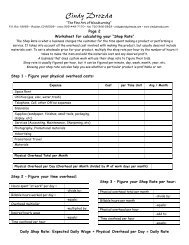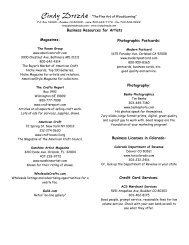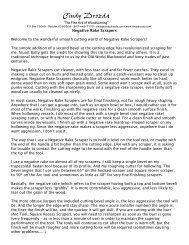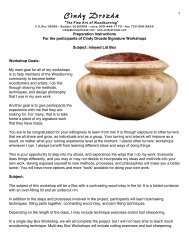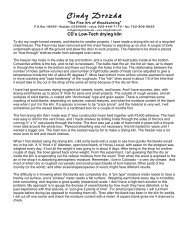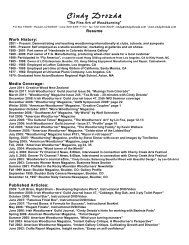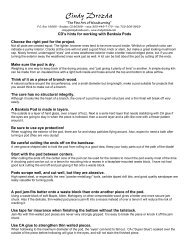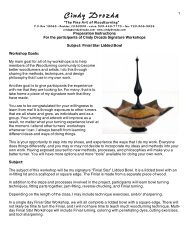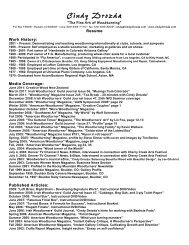Finial Design Article - Cindy Drozda
Finial Design Article - Cindy Drozda
Finial Design Article - Cindy Drozda
Create successful ePaper yourself
Turn your PDF publications into a flip-book with our unique Google optimized e-Paper software.
I<br />
admit it, I do love finials.<br />
I love the way a finial<br />
completes the personality of<br />
a lidded vessel, then invites you to<br />
reach out and lift up the lid. In my<br />
eyes, a well-done finial is<br />
a pleasing and lively composition<br />
that adds another dimension to<br />
a piece.<br />
As an artist, I love having the<br />
opportunity to express motion<br />
and energy through a finial, and<br />
I enjoy its technical challenge.<br />
By adding a finial to my vessel,<br />
I also get to indulge in my love<br />
of working in a small scale, even<br />
when I’m making a larger piece.<br />
Precise spindle work requires<br />
intense energy. There is little room<br />
for error, and the tiniest cut makes<br />
a huge difference in the finished<br />
piece. Planning the piece is critical;<br />
finial turning is not one of those<br />
projects where I want to “let the<br />
wood decide” what the finished<br />
piece will look like.<br />
The goal of this article is to<br />
explore the process of analyzing<br />
forms and compositions. Using my<br />
philosophy on finial design as an<br />
example, I present a vocabulary<br />
for describing the positive and<br />
negative design aspects of a<br />
turning. To illustrate this philosophy,<br />
I have made an 11"-tall<br />
large-scale model of one of my<br />
favorite finials. Two more models<br />
in the same scale are examples<br />
of variations on this design that I<br />
consider to have missed the mark.<br />
<strong>Finial</strong> #3 is my vision of success;<br />
#1 and #2 are the variations.<br />
Just to set things straight, I am<br />
not suggesting that my finial is the<br />
“best” finial design or that I know<br />
more about “the perfect finial”<br />
than anyone else. There is no such<br />
thing as “the perfect” shape, finial,<br />
or composition.<br />
Line describes<br />
form<br />
Woodturners often say<br />
that the form (shape)<br />
of a piece is the most<br />
important design feature.<br />
When I look at vessel and<br />
bowl forms, I see form as<br />
lines. The curve of a bowl,<br />
for example, is a single<br />
curved line. To me, this<br />
line expresses motion.<br />
The motion changes<br />
momentum and speed<br />
with the radius of the<br />
curve and the length of<br />
the line.<br />
What I refer to as the<br />
elements of a design are<br />
the composition sections<br />
where the motion of the line<br />
is interrupted, is stopped, or<br />
changes direction.<br />
An element is a form that stands<br />
alone. If we look at my finials,<br />
I consider the individual elements<br />
to be those separated by fillets<br />
or V-grooves.<br />
Combining elements in the<br />
proper proportions establishes the<br />
energy of the composition.<br />
I see my finial taking the motion<br />
of the top line of the vessel and<br />
continuing it upward so that it<br />
reaches for the sky. I want the<br />
finial to complete my vessel with a<br />
feeling of lightness and liveliness,<br />
as if it were dancing to music. To<br />
accomplish this, the elements are<br />
dramatically separated.<br />
Of course, this is not the only<br />
way to use finials—different<br />
designs might display different<br />
energy. My work expresses its<br />
unique combination of energy to<br />
evoke emotions. Another person’s<br />
work might be saying something<br />
completely different and would<br />
use different elements in a<br />
<strong>Finial</strong> 1 <strong>Finial</strong> 2 <strong>Finial</strong> 3<br />
different way, just as not all pieces<br />
of music sound alike.<br />
My hope is that members<br />
reading this article will understand<br />
how to verbalize what they<br />
are expressing in their own work.<br />
I believe that knowing the<br />
“why” of design success is<br />
important. It is not enough to<br />
say “I like it.” In fact, to say simply<br />
“I like it” might only express a<br />
personal preference. I want the<br />
ability to say “this is or is not a<br />
successful piece of artwork, and<br />
here’s why.” Being conscious of<br />
what is happening in my own and<br />
other artists’ work enables me to<br />
strive for success without relying<br />
only on trial and error.<br />
One exercise that I use is to<br />
make several examples of a design<br />
and look at them together. Taking<br />
time to just look and analyze often<br />
allows me to see what I would not<br />
have otherwise seen during the<br />
creative process. A real challenge<br />
for me is to look at work that I<br />
don’t personally care for and see it<br />
54 American Woodturner Spring 2006



